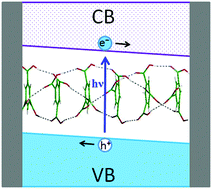Organic photovoltaics without p–n junctions: a computational study of ferroelectric columnar molecular clusters†
Abstract
Structural and electronic properties of ferroelectric columnar clusters constructed from benzene-1,3,5-tricarboxylic acid, (B3CA)N, were investigated at the Hartree–Fock level. It is shown that B3CA stacks form helix-shaped molecular tubes which are stabilized by intermolecular hydrogen bonds. It is furthermore shown that the strong electric field generated by the uniaxial alignment of the carboxyl groups can split an optically prepared exciton into an electron–hole pair and can drive the charge carriers to the opposite ends of the tube. Some consequences of the phenomenon for photovoltaic applications are discussed.


 Please wait while we load your content...
Please wait while we load your content...